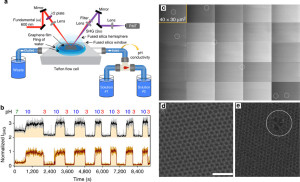
The new development provides a mechanism for engineers to design a simpler proton separation membrane.
Image: Nature Communication
We’ve all heard of graphene’s tremendous potential, which may be able to change the manufacturing process in many industries. The wonder material could make production faster, cheaper, and more efficient across the board.
Now, three ECS members have collaborated with other fellow scientists to develop a single layer graphene that could change the landscape of hydrogen fuel cell technology.
ECS members Robert Sacci, Sheng Dai, and Matthew Neurock are contributing authors on the recently published paper, “Aqueous proton transfer across single-layer graphene”.
The new research addresses the issue scientists have when attempting to separate protons from hydrogen in fuel cell technology. This new development details how a single layer of graphene and water could allow protons to move from side to side more freely.
This from Northwestern University:
The researchers discovered that naturally occurring defects in the graphene — where a carbon atom is missing — triggers a chemical merry-go-round where protons from water on one side of the membrane are shuttled to the other side in a few seconds. Their advanced computer simulations showed this occurs via a classic “bucket-line” mechanism first proposed in 1806.
Due to the speed and selectivity of the imperfect graphene membranes, an efficient mechanism for fuel cell design has been developed.
The single layer of graphene also has the potential to produce the thinnest proton channel yet.
[Sources: NYC News & Northwestern University]Join Sacci, Dai, Neurock and scientists like them by becoming a member of ECS today!


